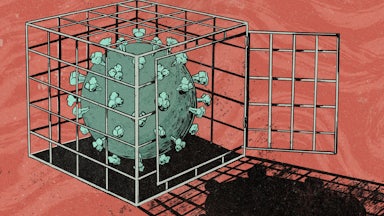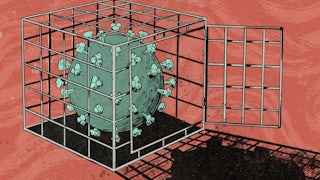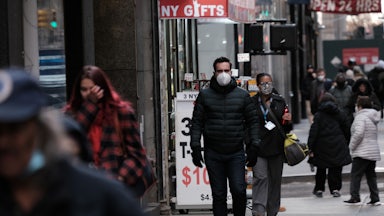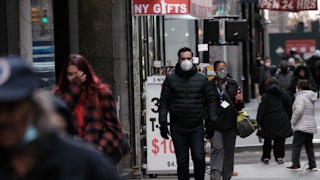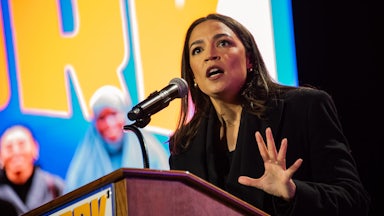There’s a moment in Our Country Friends, a 2021 novel by Gary Shteyngart, when all the paranoia, uncertainty, and disagreement comes to a blissful end. The central figure, a failing writer named Sasha, has returned to New York City with his friends and family after months at his compound upstate, where they tried to hide from Covid-19. Now summer is ending, his daughter’s school is set to reopen, and while they’re all still masking, the group’s bond is solid, the future comparatively bright. “At long last,” Shteyngart concludes, “it was time to go home.”
This is the vision many Americans have had at various points throughout the pandemic—that the end was just around the corner. All we needed was social distancing, or masking, or a vaccine, or a booster. But as each successive milestone has given way to more hardship, the truth is clearer than ever: Pandemics don’t stop—the story does.
In The Great Influenza, widely considered the definitive account of the Spanish flu, historian John M. Barry focuses the majority of his 546-page book on the years 1918 and 1919. That makes good sense—the period contained three of the deadliest waves of the virus. But Barry briefly acknowledges that the pandemic didn’t stop there. In 1920, a new variant triggered a deadly fourth wave in Detroit, Milwaukee, and Minneapolis. It wasn’t until 1921 that the national death rate returned to pre-pandemic levels. Severe respiratory infections still appeared throughout 1922. And more than a century later, the virus’s descendants continue to circulate as part of the seasonal flu rotation.
Perhaps it makes sense that the long tail of the Spanish flu, which killed an estimated 50 million people globally, is underplayed. Many communities had reached herd immunity. Over time, the virus also became significantly weaker. Even as the influenza claimed new victims, it no longer posed the same threat in the early 1920s as it had just a few years before. Over time, the virus was repositioned as a “less valiant, more feminine form of death” than the battlefield casualties of World War I, writes the scholar Elizabeth Outka in her book Viral Modernism. And survivors of both mass death events were desperate to move on from an extended period of austerity and sadness and tedium.
But on the second anniversary of our own Covid-19 pandemic, which has killed at least six million people globally, we once again find ourselves in the long and difficult gap between the end of the narrative and the continuation of our lives, now with a deadly virus in tow. The result is a kind of “narrative vertigo,” Outka recently wrote. While we’ve endured ceaseless waves of the pandemic, we still don’t have our sea legs. And the popular narratives (two shots is good—no, make it three! We’ll require vaccines in public spaces—wait, no we won’t!) that just a few months ago kept us upright no longer hold.
In times of extended uncertainty, widespread grief, and cognitive dissonance, people look to history for reassurance or novels and other art for wisdom. But the Spanish flu showed that narrative uncertainty begets narrative uncertainty. When people have no idea what to make of a collective hardship, their art can reflect that, force the issue, or maybe even offer a new perspective.
The Spanish influenza has long been called a “forgotten pandemic”—and that forgetting began early. “Novels, one would have thought, would have been devoted to influenza,” Virginia Woolf wrote in her 1926 essay “On Being Ill.” Instead, she found that literature tended to ignore the visceral reality of the body in favor of the life of the mind. Beyond Katherine Anne Porter, who in 1939 published her now-classic novella Pale Horse, Pale Rider, about a young woman who almost dies of the disease, direct references to the virus were shockingly rare.
But looking back, it’s easy to wonder if the Spanish flu suffused the art of its time in tone and tenor, if not in name. Examples are fairly easy to come by: In Nosferatu, the 1922 German film, Count Orlok possesses qualities that invoke both the Black Death and the Spanish flu. Egon Schiele produced portraits of loved ones who died; Edvard Munch depicted his own convalescence. And the specter of influenza looms over much of interwar Anglo-American literature, as Outka, the historian, argues in her book, its toll registered “in gaps, silences, atmospheres, fragments, and hidden bodies.”
For Outka, the legacy of the Spanish flu pandemic is evident in the poetry of T.S. Eliot (“The Waste Land”) and W.B. Yeats (“The Second Coming”), both of whom survived close encounters with the virus. It’s also the undercurrent of one of Woolf’s best-known works, the novel Mrs. Dalloway. Woolf, who suffered different types of influenza most years between 1916 and the publication of her book in 1925, gave her protagonist, Clarissa Dalloway, a similar backstory. The London society woman is said to have “grown white since her illness.” Her doctors have told her that the influenza has damaged her heart. While it’s easy to subsume the pandemic’s macabre creativity into the grand narrative of World War I, they lived alongside each other. One of the most memorable characters in Mrs. Dalloway suffers acutely from what is now called post-traumatic stress disorder, yet the legacy of the virus flickers in the shadows.
Today, artists interested in incorporating the pandemic into their work, or creating entirely new works around it, may find themselves in a surprising predicament: audiences, or at least the critics who claim to represent them, in revolt. In a Los Angeles Times op-ed titled, “So you want to write a pandemic novel? Here’s an idea—don’t,” the writer Tom Bissell details the numerous reasons why he believes a Covid story is dead on arrival: It’s boring, it’s too big, and no one who lived through it would be able to make it interesting. If this pandemic is ever to be fictionalized, that’s the work of artists—and audiences—of the future.
Despite the widespread aversion to the “pandemic plot,” Shteyngart isn’t the only writer who forged ahead. Isabel Allende recently published Violeta, which focuses on a woman who was born in the Spanish influenza and is now dying amid the Covid-19 pandemic. And Anne Tyler, Ian McEwan, Louise Erdrich, and Roddy Doyle are also reportedly incorporating the experience into their forthcoming fiction. Despite the preemptive criticism, “if it’s set now,” novelist Sigrid Nunez told The New York Times, “it has to be part of the story.”
The Covid-19 pandemic is a disaster unto itself. But it has also been something of a climate change laboratory. We’ve watched what happens to the world when nature catches us unprepared, when humans retreat into isolation, when the hallmarks of our society fracture like the global supply chain. The same can be true for storytelling—artists tackling one crisis may be better equipped to handle another. And there is plenty of crisis to go around.
Similar to the influenza virus–shaped hole in 1920s literature, today we face a dearth of explicit climate change fiction. Amitav Ghosh, author of The Great Derangement (essentially an “On Being Ill” for the environment), has theorized that planetary catastrophe is simply too big, too unwieldy, too absurd for good fiction. But others, like Mark Bould, author of The Anthropocene Unconscious, see the tension between humans and their environment reflected everywhere. “The art and literature of our time is pregnant with catastrophe,” he writes, “with weather and water, wildness and weirdness.” It’s not just Mad Max or Don’t Look Up, either, but the Sharknado series and the Fast and Furious franchise. Climate change, Bould argues, “is the central subject of our collective unconscious.” We just need to name it.
The next pandemic plot point remains a mystery—is it over? Are we waiting for the next wave? How much longer can we carry on?—as does its place in the larger narrative of our apocalyptic era. It’s temping to look away. We may live in interesting times, but living through them is often boring as hell. Still, these are events that can’t be shied away from. While art alone won’t dictate how this pandemic is remembered, it might help us make sense of the present—and leave something for a future that will recognize itself in our experiences. To stop writing now, in the middle of the story, will mean we keep seeking an “end” but never move forward.

